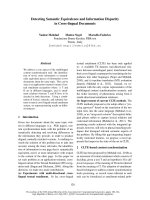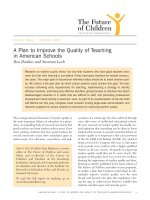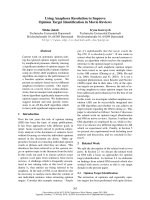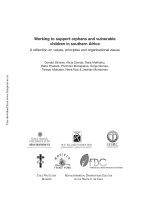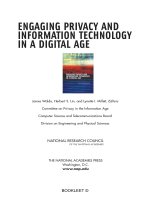Using Cooperative Learning to Integrate Thinking and Information Technology in a Content.doc
Bạn đang xem bản rút gọn của tài liệu. Xem và tải ngay bản đầy đủ của tài liệu tại đây (112.39 KB, 9 trang )
Using Cooperative Learning to Integrate
Thinking and Information Technology in a
Content-Based Writing Lesson
Gabriel Tan (Xinmin Secondary School, Singapore)
Patrick B Gallo (SEAMEO Regional Language Centre)
George M Jacobs (SEAMEO Regional Language Centre)
Christine Kim-Eng Lee (Nanyang Technological University)
Abstract
Cooperative learning can be defined as a range of concepts and techniques for enhancing
the value of student-student interaction. The article begins with separate discussions of how
cooperative learning promotes effective instruction of thinking skills and creativity, and of
information technology. Thinking skills and creativity are promoted when students interact
with their peers to brainstorm, explain, question, disagree, persuade, and problem-solve.
Cooperative learning offers many tools for structuring this type of thinking interaction.
Educational applications of information technology are enhanced by peer interaction in
cooperative learning groups, as students can engage in peer tutoring, model effective
behaviours, communicate electronically, and take on a range of roles while working at the
computer.
Next, the authors describe a content-based writing lesson for secondary school students in
Singapore in which cooperative learning is integrated with thinking and creativity, and with
information technology. Explanations are provided of how key cooperative learning
concepts are embodied in the lesson. Materials used in the lesson are made available.
Introduction
In this article, we present a blending of three important trends in education: cooperative
learning (CL), thinking and creativity (TC), and information technology (IT). Elsewhere,
authors of this paper have considered the integration of cooperative learning with TC (Lee,
Ng, & Jacobs, 1998) and with IT (Jacobs, Ward, & Gallo, 1997). Below, we briefly review
key elements of cooperative learning and then describe some of its links with thinking and
creativity and information technology. The main part of the article consists of a description
of a Singapore secondary school Geography/English lesson taught by the first author in
which cooperative learning, thinking and creativity, and information technology were
woven together.
Singapore has a bilingual education policy in which from primary school the medium of
instruction is English, with students studying their mother tongue (usually Malay,
Mandarin, or Tamil) as a subject. The secondary school at which the lesson was used is
what in Singapore is called a neighbourhood school. This is the type that most students
attend, rather than autonomous or independent schools that are more selective as to whom
they admit. Students attend secondary school from approximately 13-16 years of age. Class
size is normally about 40 students. The normal period lasts 35 minutes.
Cooperative Learning
Cooperative learning can be defined as a variety of concepts and techniques for enhancing
the value of student-student interaction. In one well-known operationalization of
cooperative learning (Johnson, Johnson, & Holubec, 1993), key concepts include:
1. Positive interdependence - the feeling among a group of students that they sink or
swim together, i.e., that what helps one helps all, and that what hurts one hurts all.
2. Individual accountability - the feeling among a group that each member is
responsible for their own learning as well as that of their groupmates.
3. Collaborative skills - these skills, that students need to cooperate successfully, often
must be explicitly taught.
4. Processing group interaction - time spent for groups to think about how well they
have collaborated and how to enhance their future collaboration.
5. Heterogeneous grouping - students working with groupmates who are different
from them on such variables as sex, past achievement, ethnicity, and diligence.
Research on cooperative learning (Bossert, 1988-1989; Cohen, 1994; Johnson & Johnson,
1989; Sharan, 1980; Slavin, 1995) across a wide range of academic subject areas and age
groups suggests that the use of cooperative learning may be associated with gains on the
following variables:
1. Achievement
2. Liking for school
3. Inter-ethnic relations
4. Thinking skills
5. Self-esteem.
6. Enjoyment
Cooperative Learning and Thinking and Creativity
Cooperative learning is believed to promote thinking and creativity in many ways
(Hythecker, Dansereau, & Rocklin, 1988; Qin, Johnson, & Johnson, 1995; Webb, 1989),
including:
1. Compared to a whole class format, in cooperative learning, students have more
opportunities to talk and to share ideas. This interaction with groupmates
encourages students to restructure their ideas. For instance, they may need to
summarize, elaborate, exemplify, defend, and explain their ideas.
2. Disagreement, if carried out constructively, pushes students to clarify and rethink
their ideas, potentially leading to cognitive restructuring.
3. By working in groups, students enjoy more opportunity to see how their peers think
and create new ideas. Witnessing this process can provide useful models.
4. Discussing, creating, and thinking in a group, rather than in a whole class context,
can provide a less anxiety-producing context. If groupmates feel positively
interdependent with one another, a supportive atmosphere can develop. In such an
atmosphere, students may feel more free to try out new ideas.
5. The multiple perspectives of others in their heterogeneous groups may spark new
ideas in students' minds.
6. The greater achievement that cooperative learning can foster provides students with
a stronger knowledge base from which to explore concepts.
Cooperative Learning and Information Technology
The use of groups (most of the cooperative learning literature recommends groups of 2-4
students) is advocated for information technology-based learning by several educators
(Beauvois, 1998; Braine, 1998; Chang & Smith, 1991; Johnson & Johnson, 1985;
Warschauer, 1996, 1997). Potential advantages of student collaboration during IT lessons
include:
1. Computers can isolate students -- think of the stereotype of the computer nerd,
locked alone in a room all day staring at a computer screen, whereas cooperative
learning brings a social element to information technology-based learning.
2. Because computers offer a variety of engaging, multi-media ways for obtaining
large amounts of information, e.g., CD-ROMs and web sites, students are now less
dependent on teachers for information, and instead can work together to find and
share knowledge. All the same benefits of cooperative learning presented above in
the normal classroom apply equally in information technology -based lessons.
3. Cooperative learning helps students learn with computers, and, at the same time,
computers furnish students new ways to collaborate with others, such as email,
networked computers, and sharing of diskettes.
Student-student collaboration can take place at four points during Iinformation technology
-based lessons.
1. Prior to working with computers, students can discuss concepts in the lesson and
plan what they will do.
2. While using computers, students can discuss - either orally or via computer - what
they are working on and can take different roles, e.g., keyboard captain and
navigator, if they are at the same computer. Also, while one or more group
members is at a computer, others can be engaged in aspects of their group's work
that do not involve IT.
3. During a pause in computer use, students can analyze what they have learned and
done, share information with others, and plan their next steps.
4. After using computers, students can again analyze and share what they have
learned and done, as well as what they need to do next.
Lesson Plan - Using the Internet for Pre-Writing
Subject / Focus : Geography/ English Language / Narrative Writing
Level : Secondary 3 Express
Topic : Endangered Species (Various Issues)
Duration : 8 periods (four of which are computer-based)
Grouping : Groups of 4 mixed in terms of past achievement and sex
Prerequisites:
1. Pupils should be familiar with word processing software (MS Word), web
browsers, and WWW search engines.
2. Pupils have studied the first person narrative genre - including setting,
characterisation, and plot development - and the teacher and class have looked at
model texts and jointly constructed a text in that genre.
What is K-W-L
K-W-L (Ogle, 1986) is a three-step reading technique that fosters active reading, used
mainly for expository texts.
1. K - what I Know - the teacher leads students in brainstorming what they already
know about a topic and how they have acquired this information. The teacher then
helps students to put these ideas into more general categories.
2. W - what I Want to know - As the students think about the topic and the general
categories of information, they generate questions about aspects of the topic about
which they would like to know more.
3. L - what I've Learned - The students read a text (print or electronic) to find answers
to their questions. During reading, students record the new knowledge that they
have learned in the respective categories. They can continue to find answers to
unanswered questions after the lesson via further reading or other forms of
research.
Learning Environment
1. Room with about 20 computers for individual research
2. Multimedia computers and one projector
Lesson Procedure
Pre-Writing
Starter
The teacher explains to the class that in this unit they will write a first person narrative
essay from the point of view of an endangered animal. Students will each write using one
of the following frameworks:
(a) A day in the life on an endangered animal
(b) My most memorable experience as a (name of endangered animal, e.g., juvenile panda,
etc)
(c) My most frightening experience as a (name of endangered animal, e.g., Bengal tiger)
(d) Any other suitable first person narrative framework suggested by students
The teacher then explains that in pairs the students will make use of the WWW to do
research on an endangered species of their choice (Each pair will work on an animal they
agree upon.) During their research, they are to search for relevant information pertinent to
the setting, characters, and plot of their stories)
Class Discussion
In the initial class discussion, the teacher seeks to familiarise students with the 'K'; part of
K-W-L, particularly how they can generate categories for use later in their Internet
research. To do this, the teacher selects one endangered animal - the tiger - and asks
students to contribute whatever knowledge they already have on tigers. The teacher then
puts these contributions on a MS Word document which is projected on a screen for all
students to see. The advantage of carrying out this procedure on a word processor lies in
the mobility of the texts - the teacher can 'cut and paste' students' contributions and move
them around. Once students have contributed their prior knowledge about the tiger, the
teacher helps the students to rearrange their ideas into categories. They should be able to
generate at least the following categories:
• (a) Physical Characteristics
• (b) Natural Habitats
• (c) Diet
• (d) Social Habits (Mating, Hierarchy, etc)
• (e) Reasons why they are endangered
• (f) Ways and efforts to save them
(This part constitutes the K of K-W-L)
The teacher explains that these categories can be used as 'handles' in their Internet research,
whatever endangered species they choose. Armed with these categories, students can later
return to do the 'K'; step for the animal chosen by their pair.
Groupwork (On the Computer)
The teacher provides a list of four endangered animal species. Each student chooses one to
learn more about, and the teacher assigns students to pairs so as to create groups that are
heterogeneous as to English proficiency, and, if possible, sex. Students then visit the World
Wildlife Foundation site, which has a list of endangered species, to survey the range of
animals that are currently on the 'threatened' list:



